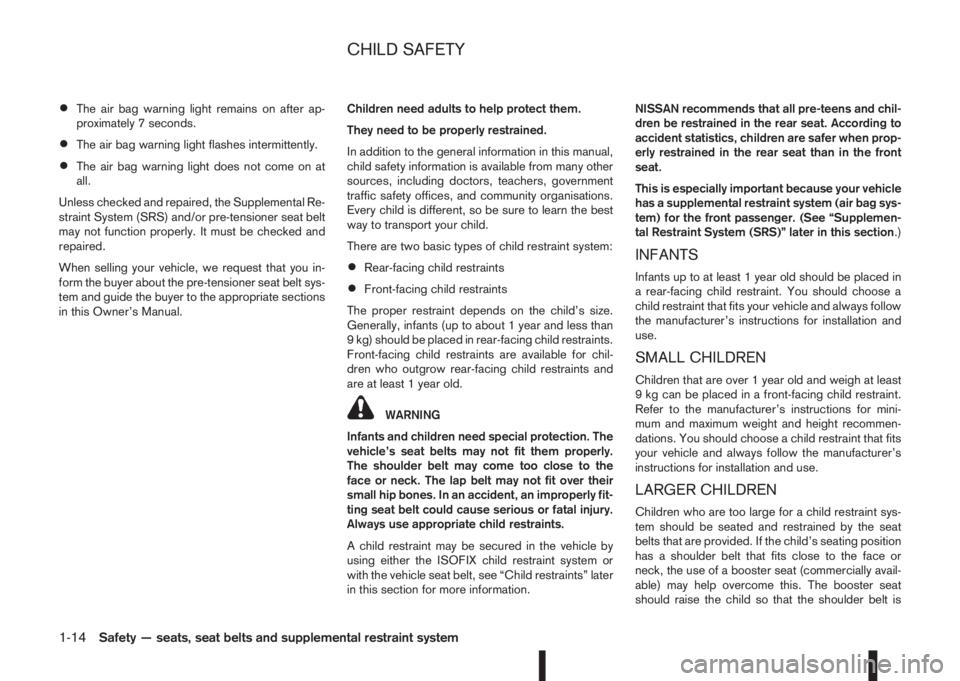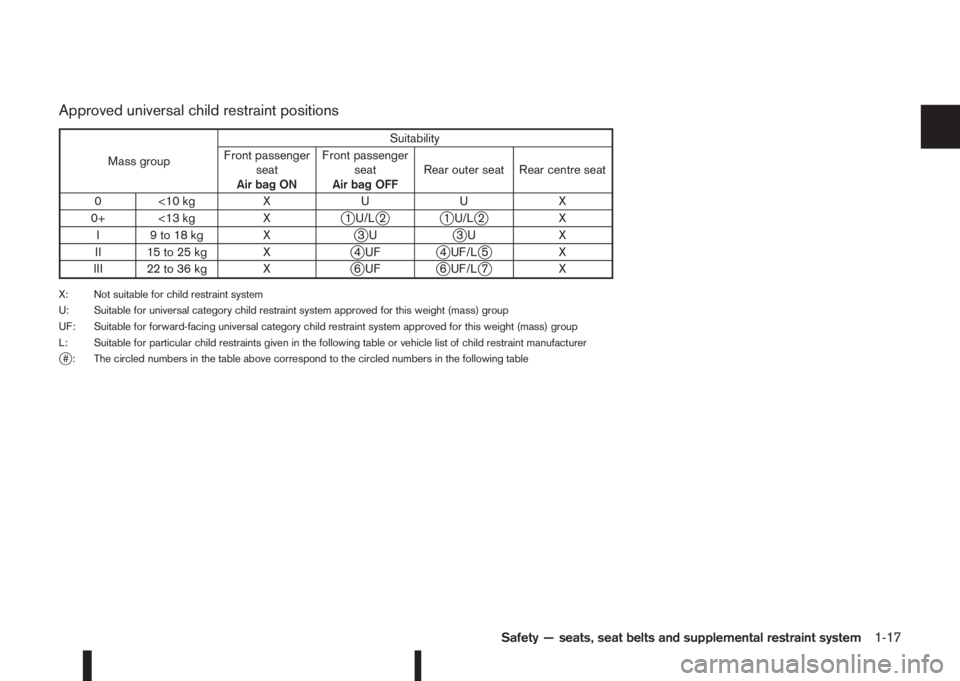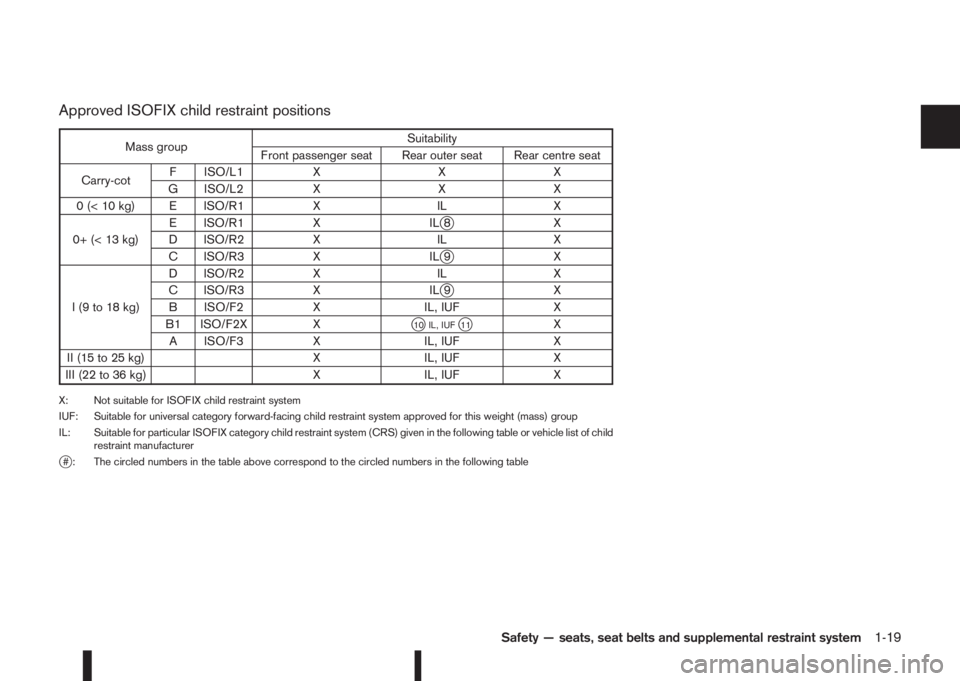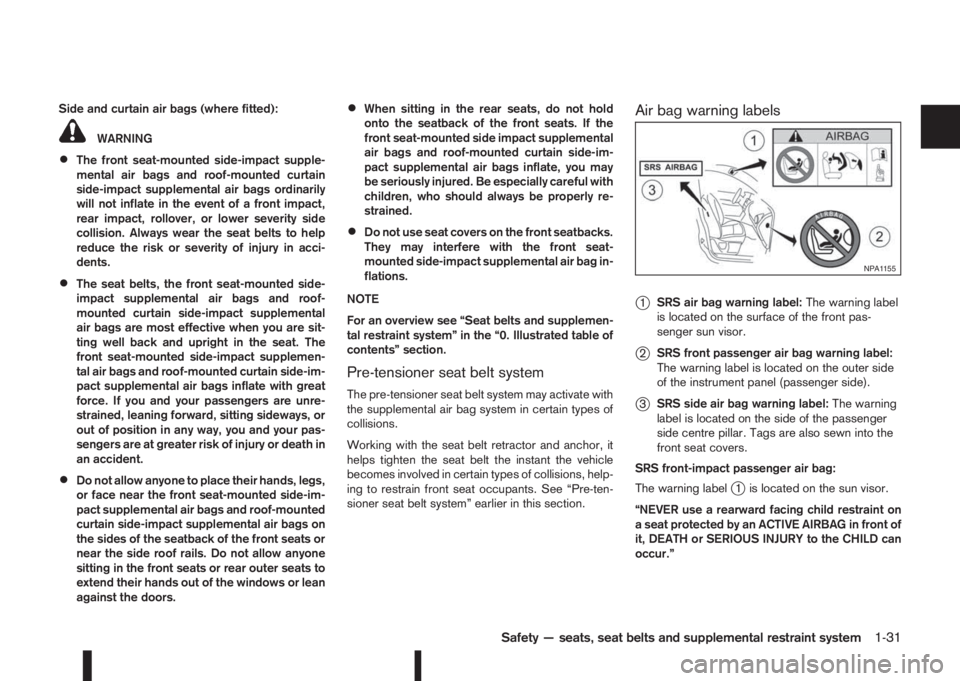2014 NISSAN QASHQAI ESP
[x] Cancel search: ESPPage 12 of 338

LEFT HAND DRIVE
1.Wiper and washer switch (P. 2-32)
2.Steering wheel switches
— Cruise control* (P. 5-36)
— Speed limiter* (P. 5-38)
— Mobile phone integration for FM-AM radio
with CD player without navigation (P. 4-39)— Mobile phone integration for
NissanConnect* *1
3.Steering wheel
— Electric power steering system (P. 5-57)
— Horn (P. 2-41)
— Driver’s supplemental front-impact air bag
(P. 1-29)
4.Steering wheel switches— Vehicle information display switches
(P. 2-13)
— Audio switches* (P. 4-38)
5.Headlight and turn signal switch (P. 2-36)
6.TRIP/RESET/brightness switches
— Instrument brightness switch (P. 2-3)
— TRIP/RESET switch for twin trip odometer
(P. 2-2)
7.Switch panel
— Electronic Stability Programme (ESP) OFF
switch* (P. 5-60)
— ECO mode switch* (P. 5-65)
— Stop/Start System OFF switch* (P. 5-22)
— Ultrasonic Parking Sensor switch* (P. 5-45)
— Headlight aiming control switch* (P. 2-39)
— 2WD/4WD switch* (P. 5-26)
— Headlight cleaner switch* (P. 2-40)
8.— Fuel filler lid release handle (P. 3-15)
— Bonnet release handle (P. 3-14)
9.Front cup holders (P. 2-44)
10.Electric parking brake (P. 3-16)
11.Shift lever (P. 5-17)
12.Power outlet (P. 2-42)
* where fitted
*1Refer to the separately provided NissanConnect
Owner’s Manual.
NPA1268
COCKPIT
0-6Illustrated table of contents
Page 13 of 338

RIGHT HAND DRIVE
1.Headlight and turn signal switch (P. 2-36)
2.Steering wheel switches
— Vehicle information display switches
(P. 2-13)
— Audio switches* (P. 4-38)
3.Steering wheel— Electric power steering system (P. 5-57)
— Horn (P. 2-41)
— Driver’s supplemental front-impact air bag
(P. 1-29)
4.Steering wheel switches
— Cruise control* (P. 5-36)
— Speed limiter* (P. 5-38)
— Mobile phone integration for FM-AM radiowith CD player without navigation* (P. 4-39)
— Mobile phone integration for
NissanConnect* *
1
5.Wiper and washer switch (P. 2-32)
6.TRIP/RESET/brightness switches
— Instrument brightness switch (P. 2-3)
— TRIP/RESET switch for twin trip odometer
(P. 2-2)
7.Switch panel
— Electronic Stability Programme (ESP) OFF
switch* (P. 5-60)
— ECO mode switch* (P. 5-65)
— Stop/Start System OFF switch* (P. 5-22)
— Ultrasonic Parking Sensor switch* (P. 5-45)
— Headlight aiming control switch* (P. 2-39)
— 2WD/4WD switch (P. 5-26)
8.— Fuel filler lid release handle (P. 3-15)
— Bonnet release handle (P. 3-14)
9.Front cup holders (P. 2-44)
10.Electric parking brake (P. 3-16)
11.Shift lever (P. 5-17)
12.Power outlet (P. 2-42)
* where fitted
*
1Refer to the separately provided NissanConnect
Owner’s Manual.
NPA1248
Illustrated table of contents0-7
Page 34 of 338

•The air bag warning light remains on after ap-
proximately 7 seconds.
•The air bag warning light flashes intermittently.
•The air bag warning light does not come on at
all.
Unless checked and repaired, the Supplemental Re-
straint System (SRS) and/or pre-tensioner seat belt
may not function properly. It must be checked and
repaired.
When selling your vehicle, we request that you in-
form the buyer about the pre-tensioner seat belt sys-
tem and guide the buyer to the appropriate sections
in this Owner’s Manual.Children need adults to help protect them.
They need to be properly restrained.
In addition to the general information in this manual,
child safety information is available from many other
sources, including doctors, teachers, government
traffic safety offices, and community organisations.
Every child is different, so be sure to learn the best
way to transport your child.
There are two basic types of child restraint system:
•Rear-facing child restraints
•Front-facing child restraints
The proper restraint depends on the child’s size.
Generally, infants (up to about 1 year and less than
9 kg) should be placed in rear-facing child restraints.
Front-facing child restraints are available for chil-
dren who outgrow rear-facing child restraints and
are at least 1 year old.
WARNING
Infants and children need special protection. The
vehicle’s seat belts may not fit them properly.
The shoulder belt may come too close to the
face or neck. The lap belt may not fit over their
small hip bones. In an accident, an improperly fit-
ting seat belt could cause serious or fatal injury.
Always use appropriate child restraints.
A child restraint may be secured in the vehicle by
using either the ISOFIX child restraint system or
with the vehicle seat belt, see “Child restraints” later
in this section for more information.NISSAN recommends that all pre-teens and chil-
dren be restrained in the rear seat. According to
accident statistics, children are safer when prop-
erly restrained in the rear seat than in the front
seat.
This is especially important because your vehicle
has a supplemental restraint system (air bag sys-
tem) for the front passenger. (See “Supplemen-
tal Restraint System (SRS)” later in this section.)
INFANTS
Infants up to at least 1 year old should be placed in
a rear-facing child restraint. You should choose a
child restraint that fits your vehicle and always follow
the manufacturer’s instructions for installation and
use.
SMALL CHILDREN
Children that are over 1 year old and weigh at least
9 kg can be placed in a front-facing child restraint.
Refer to the manufacturer’s instructions for mini-
mum and maximum weight and height recommen-
dations. You should choose a child restraint that fits
your vehicle and always follow the manufacturer’s
instructions for installation and use.
LARGER CHILDREN
Children who are too large for a child restraint sys-
tem should be seated and restrained by the seat
belts that are provided. If the child’s seating position
has a shoulder belt that fits close to the face or
neck, the use of a booster seat (commercially avail-
able) may help overcome this. The booster seat
should raise the child so that the shoulder belt is
CHILD SAFETY
1-14Safety — seats, seat belts and supplemental restraint system
Page 37 of 338

Approved universal child restraint positions
Mass groupSuitability
Front passenger
seat
Air bag ONFront passenger
seat
Air bag OFFRear outer seat Rear centre seat
0 <10 kg X U U X
0+ <13 kg X
j1 U/Lj2j1 U/Lj2X
I 9 to 18 kg X
j3Uj3U X
II 15 to 25 kg X
j4UFj4 UF/Lj5X
III 22 to 36 kg X
j6UFj6 UF/Lj7X
X: Not suitable for child restraint system
U: Suitable for universal category child restraint system approved for this weight (mass) group
UF: Suitable for forward-facing universal category child restraint system approved for this weight (mass) group
L: Suitable for particular child restraints given in the following table or vehicle list of child restraint manufacturer
j# : The circled numbers in the table above correspond to the circled numbers in the following table
Safety — seats, seat belts and supplemental restraint system1-17
Page 39 of 338

Approved ISOFIX child restraint positions
Mass groupSuitability
Front passenger seat Rear outer seat Rear centre seat
Carry-cotF ISO/L1 X X X
G ISO/L2 X X X
0 (< 10 kg) E ISO/R1 X IL X
0+ (< 13 kg)E ISO/R1 X IL
j8X
D ISO/R2 X IL X
C ISO/R3 X IL
j9X
I(9to18kg)D ISO/R2 X IL X
C ISO/R3 X IL
j9X
B ISO/F2 X IL, IUF X
B1 ISO/F2X X
j10 IL, IUFj11X
A ISO/F3 X IL, IUF X
II (15 to 25 kg) X IL, IUF X
III (22 to 36 kg) X IL, IUF X
X: Not suitable for ISOFIX child restraint system
IUF: Suitable for universal category forward-facing child restraint system approved for this weight (mass) group
IL: Suitable for particular ISOFIX category child restraint system (CRS) given in the following table or vehicle list of child
restraint manufacturer
j# : The circled numbers in the table above correspond to the circled numbers in the following table
Safety — seats, seat belts and supplemental restraint system1-19
Page 51 of 338

Side and curtain air bags (where fitted):
WARNING
•The front seat-mounted side-impact supple-
mental air bags and roof-mounted curtain
side-impact supplemental air bags ordinarily
will not inflate in the event of a front impact,
rear impact, rollover, or lower severity side
collision. Always wear the seat belts to help
reduce the risk or severity of injury in acci-
dents.
•The seat belts, the front seat-mounted side-
impact supplemental air bags and roof-
mounted curtain side-impact supplemental
air bags are most effective when you are sit-
ting well back and upright in the seat. The
front seat-mounted side-impact supplemen-
tal air bags and roof-mounted curtain side-im-
pact supplemental air bags inflate with great
force. If you and your passengers are unre-
strained, leaning forward, sitting sideways, or
out of position in any way, you and your pas-
sengers are at greater risk of injury or death in
an accident.
•Do not allow anyone to place their hands, legs,
or face near the front seat-mounted side-im-
pact supplemental air bags and roof-mounted
curtain side-impact supplemental air bags on
the sides of the seatback of the front seats or
near the side roof rails. Do not allow anyone
sitting in the front seats or rear outer seats to
extend their hands out of the windows or lean
against the doors.
•When sitting in the rear seats, do not hold
onto the seatback of the front seats. If the
front seat-mounted side impact supplemental
air bags and roof-mounted curtain side-im-
pact supplemental air bags inflate, you may
be seriously injured. Be especially careful with
children, who should always be properly re-
strained.
•Do not use seat covers on the front seatbacks.
They may interfere with the front seat-
mounted side-impact supplemental air bag in-
flations.
NOTE
For an overview see “Seat belts and supplemen-
tal restraint system” in the “0. Illustrated table of
contents” section.
Pre-tensioner seat belt system
The pre-tensioner seat belt system may activate with
the supplemental air bag system in certain types of
collisions.
Working with the seat belt retractor and anchor, it
helps tighten the seat belt the instant the vehicle
becomes involved in certain types of collisions, help-
ing to restrain front seat occupants. See “Pre-ten-
sioner seat belt system” earlier in this section.
Air bag warning labels
j
1SRS air bag warning label:The warning label
is located on the surface of the front pas-
senger sun visor.
j2SRS front passenger air bag warning label:
The warning label is located on the outer side
of the instrument panel (passenger side).
j3SRS side air bag warning label:The warning
label is located on the side of the passenger
side centre pillar. Tags are also sewn into the
front seat covers.
SRS front-impact passenger air bag:
The warning label
j1 is located on the sun visor.
“NEVER use a rearward facing child restraint on
a seat protected by an ACTIVE AIRBAG in front of
it, DEATH or SERIOUS INJURY to the CHILD can
occur.”
NPA1155
Safety — seats, seat belts and supplemental restraint system1-31
Page 62 of 338

Anti-lock Braking System (ABS) warn-
ing lightSeat belt (driver and front passenger)
warning lightFront fog light indicator light
Brake warning light (red)Supplemental Restraint System
(SRS) air bag warning lightGlow plug indicator light* (Diesel
engine)
Charge warning lightWater in fuel filter warning light*High beam assist indicator light*
Forward Emergency Braking system
warning light*
Front passenger air bag status light*
High beam indicator light
Low tyre pressure warning light*Rear fog light indicator light*
Malfunction warning light (red)*
Malfunction indicator light (orange)4WD mode indicator light (AUTO)*Side light and headlight indicator
light
Master warning light4WD mode indicator light (LOCK)*Slip indicator light
NATS security warning lightDipped beam indicator lightTrailer direction indicator light
Parking brake warning lightDoor lock indicator light*Turn signal/hazard indicator lights
Power steering warning lightElectronic Stability Programme (ESP)
OFF indicator light*: where fitted
CHECKING BULBS
With all doors closed, apply the parking brake, fas-
ten the seat belts and turn the ignition switch to the
ON position without starting the engine.The following lights (where fitted) come on briefly
and then go off:,,,,,,,
,,,,,,
If any light fails to come on, it may indicate a burned-
out bulb or an open circuit in the electrical system.Have the system checked, and repaired promptly by
a NISSAN dealer or qualified workshop.
Some indicators and warnings are also displayed in
the vehicle informational display between the speed-
ometer and tachometer see “Vehicle information
display” later in this section.
WARNING/INDICATOR LIGHTS AND AUDIBLE REMINDERS
2-4Instruments and controls
Page 63 of 338

WARNING LIGHTS
Also see “Vehicle information display” later in this
section.
Anti-lock Braking System (ABS)
warning light
When the ignition switch is in the ON position, the
Anti-lock Braking System (ABS) warning light illumi-
nates and then turns off. This indicates the ABS is
operational.
If the ABS warning light illuminates while the engine
is running, or while driving, it may indicate the ABS
is not functioning properly. Have the system
checked by a NISSAN dealer or qualified workshop.
If an ABS malfunction occurs, the anti-lock function
is turned off. The brake system then operates nor-
mally, but without anti-lock assistance (see “Brake
system” in the “5. Starting and driving” section).
BRAKE warning light (red)
When the ignition switch is placed in the ON posi-
tion, the light remains illuminated for a few seconds.
If the light illuminates at any other time, it may indi-
cate that the brake system is not functioning prop-
erly. If the BRAKE warning light illuminates, stop the
vehicle immediately and contact a NISSAN dealer
or qualified workshop.
Low brake fluid warning light:
When the ignition switch is in the ON position, the
light warns of a low brake fluid level. If this warning
light illuminates, the Electronic Stability Programme(ESP) warning light and the brake system warning
light (yellow) also illuminate. If the light illuminates
while the ignition switch is in the ON position with
the parking brake not applied, stop the vehicle and
perform the following steps:
1. Check the brake fluid level. If brake fluid level is
low, add fluid and have the system checked by a
NISSAN dealer or qualified workshop. See
“Brake and clutch fluid” in the “8. Maintenance
and do-it-yourself” section.
2. If the brake fluid level is correct, have the warn-
ing system checked by a NISSAN dealer or quali-
fied workshop.
WARNING
•Your brake system may not be working prop-
erly if the warning light is on. Driving could be
dangerous. If you judge the brake system to
be safe, drive carefully to the nearest service
station for repairs. Otherwise, have your ve-
hicle towed because driving it could be dan-
gerous.
•Pressing the brake pedal when the ignition
switch is not in the ON position and/or when
the brake fluid level is low may increase the
stopping distance and braking will require
greater pedal effort as well as pedal travel.
•If the brake fluid level is below the minimum
or MIN mark on the brake fluid reservoir, do
not drive until the brake system has been
checked at a NISSAN dealer or qualified work-
shop.
Charge warning light
When the ignition switch is in the ON position, the
charge warning light illuminates. After starting the
engine, the charge warning light turns off. This indi-
cates that the charging system is operational.
If the charge warning light illuminates while the en-
gine is running, or while driving, it may indicate that
the charging system is not functioning properly and
may need servicing.
When the charge warning light illuminates while driv-
ing, stop the vehicle safely as soon as possible.
Stop the engine and check the alternator belt. If the
alternator belt is loose, broken or missing, the charg-
ing system needs repair (see “Drive belts” in the
“8. Maintenance and do-it-yourself” section).
If the alternator belt appears to be functioning cor-
rectly but the charge warning light remains illumi-
nated, have the charging system checked by a
NISSAN dealer or qualified workshop promptly.
CAUTION
Do not continue driving if the alternator belt is
loose, broken or missing.
Forward Emergency Braking
system warning light
(where fitted)
This light illuminates when the Forward Emergency
Braking system is set to OFF on the lower display.
If the light illuminates when the Forward Emergency
Braking system is ON, it may indicate that the sys-
Instruments and controls2-5